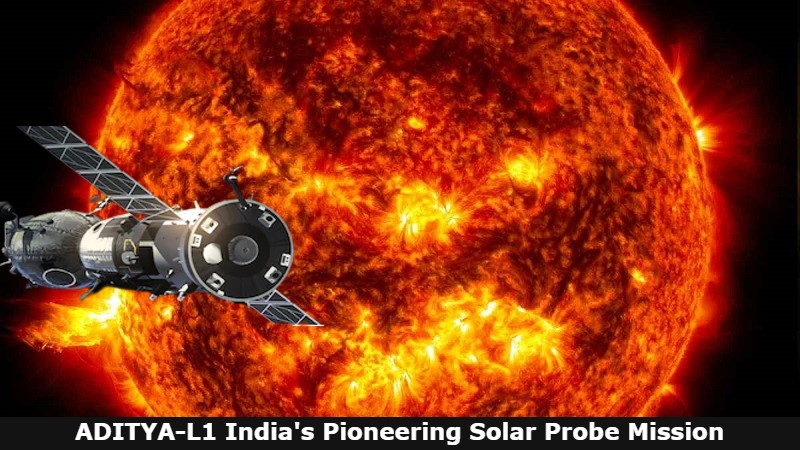Table of Contents
Unveiling the Aditya-L1 Mission
ADITYA-L1 India’s Pioneering Solar Probe Mission. In the heart of India’s ambitious space exploration endeavors lies the Aditya-L1 mission, a groundbreaking venture aimed at unraveling the mysteries of our closest star, the Sun. Scheduled for launch on September 2, 2023, by the Indian Space Research Organization (ISRO), Aditya-L1 marks India’s maiden foray into dedicated solar observation missions, making it a pivotal moment in the country’s space exploration history.
ADITYA-L1 India’s Pioneering Solar Probe Mission
ADITYA-L1 India’s Pioneering Solar Probe Mission, an acronym for “Aditya-Lagrangian-1,” is named after the revered Hindu Sun God, Aditya. The mission’s primary objective is to study the Sun’s outermost layer, known as the solar corona, and the solar wind, which plays a crucial role in space weather and its impact on Earth. This solar observatory mission is set to occupy a halo orbit around the first Lagrangian point (L1), which is approximately 1.5 million kilometers from Earth. This strategic location offers a stable and uninterrupted view of the Sun, allowing Aditya-L1 to capture vital data with precision.
Seven Payloads for Scientific Excellence
To achieve its mission goals, Aditya-L1 is equipped with seven scientific payloads, each tailored to scrutinize different aspects of the Sun:
- Visible Emission Line Coronagraph (VELC): Designed to study the solar corona’s dynamics and thermal properties, VELC will provide valuable insights into the Sun’s outer atmosphere.
- Solar Ultraviolet Imaging Telescope (SUIT): SUIT will focus on capturing high-resolution images of the Sun’s chromosphere and the dynamics of its magnetic field.
- Plasma Analyser Package for Aditya (PAPA): PAPA aims to analyze the composition and variations in the solar wind, helping us understand its influence on space weather.
- Aditya Solar Wind Particle Experiment (ASPEX): ASPEX will investigate the characteristics of solar wind ions, shedding light on their behavior and impact on the Earth.
- Magnetometer: The magnetometer will measure the Sun’s magnetic field’s strength and fluctuations, contributing to our understanding of solar activity.
- High-Energy L1 Orbiting X-ray Spectrometer (HEL1OS): Focusing on high-energy X-rays, HEL1OS will study the dynamics of the solar corona and provide data on solar flares and other energetic events.
- Dual Frequency Radioheliograph (DFR): DFR will observe the Sun’s radio emissions, enabling scientists to probe the solar atmosphere’s properties and fluctuations.
Significance of the Aditya-L1 Mission
The Aditya-L1 mission holds immense significance for scientific research and space weather forecasting. By delving into the Sun’s behavior and its impact on the solar system, Aditya-L1 will address critical questions about space weather phenomena, such as solar flares, geomagnetic storms, and their effects on Earth’s technology and communication systems.
Furthermore, understanding solar activity is vital for space exploration missions, satellite operations, and even aviation, as it helps predict and mitigate potential hazards associated with space weather.
India’s Growing Influence in Space Exploration
As India prepares to launch Aditya-L1, it reinforces the nation’s growing stature in space exploration. ISRO, renowned for its cost-effective and reliable space missions, is poised to make significant contributions to our understanding of the Sun’s dynamic behavior. With Aditya-L1, India joins a select group of nations actively engaged in solar research, showcasing its commitment to advancing scientific knowledge for the benefit of all.
Conclusion
The Aditya-L1 mission represents a remarkable leap forward in India’s space exploration journey. With its cutting-edge technology and ambitious scientific objectives, it promises to expand our understanding of the Sun’s intricate workings and their profound impact on our world. As the launch date approaches, the world eagerly anticipates the insights and discoveries that Aditya-L1 will undoubtedly bring to the forefront of solar science.
In a world where knowledge is power, Aditya-L1 exemplifies India’s dedication to pushing the boundaries of scientific discovery, ultimately enriching our comprehension of the universe.
To check more trending news click here.
⚡ Quick Search
- newsonair.gov.in – ISRO to launch Aditya-L1 to study Sun on Sept 2
- space.com – India to launch Aditya-L1, its 1st solar probe, on Sept. 2
- techcrunch.com – India to launch solar observatory mission Aditya-L1 this week
- economictimes.com – aditya l1: Isro wants a place in the Sun, sets September 2 …
- indianexpress.com – What is ISRO’s Aditya-L1 mission
- bbc.com – Why India dey launch mission to study di Sun?


No Comment